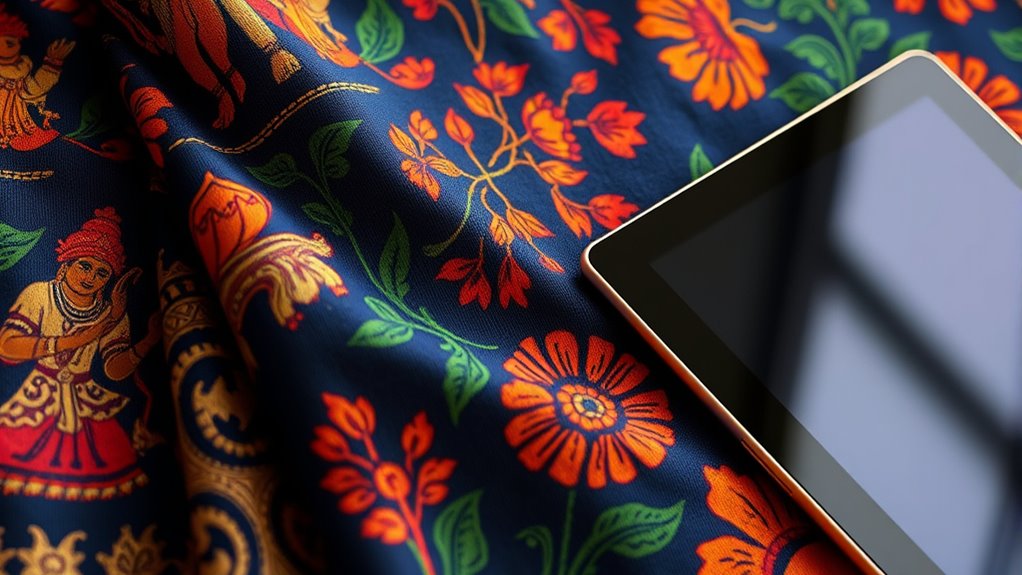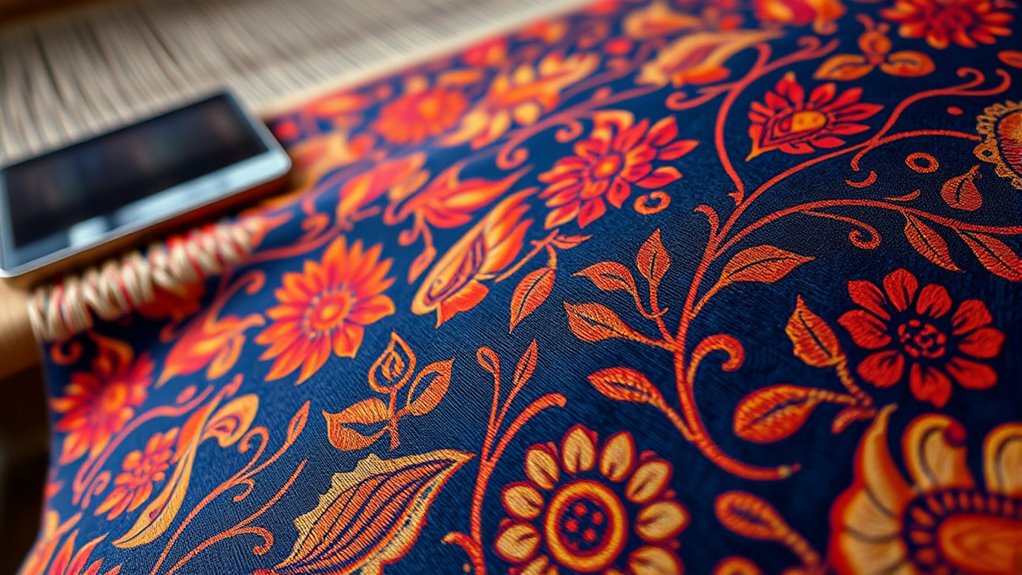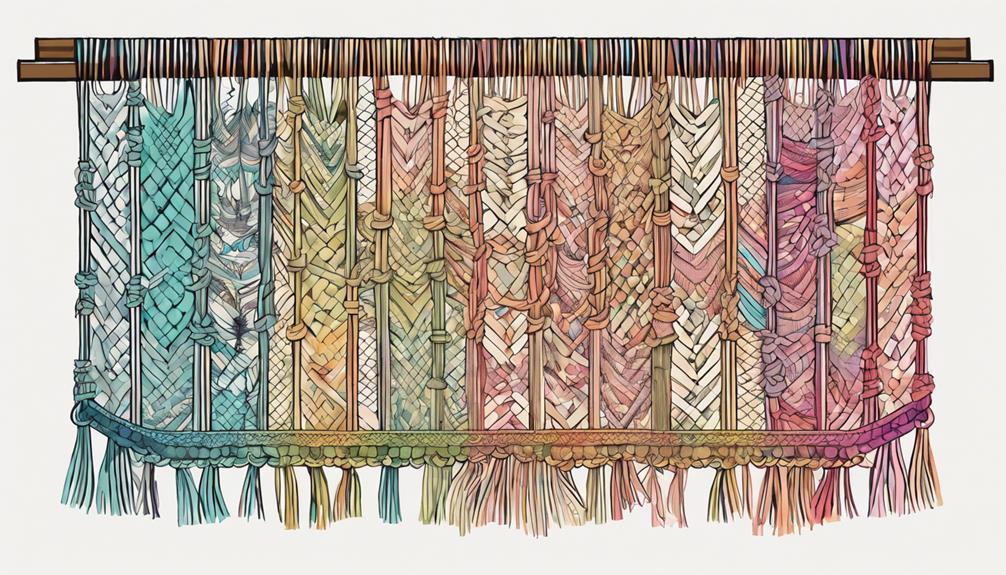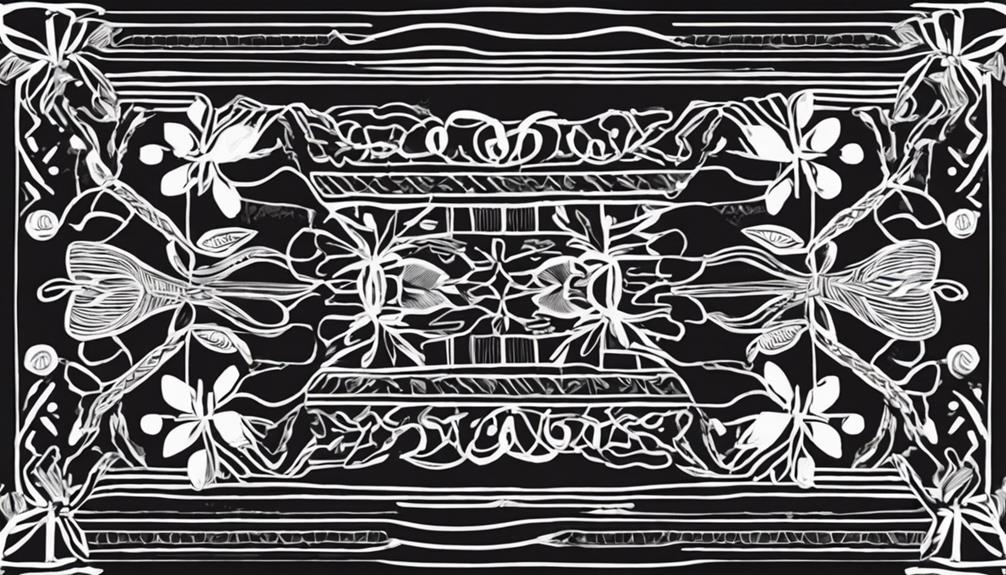Kalamkari, an ancient Indian textile art, is experiencing a high-tech revival that preserves its mythological themes and craftsmanship. By integrating sustainable fabrics like organic cotton and natural dyes, artisans maintain authenticity while supporting environmental goals. Modern techniques like digital printing help reproduce intricate designs efficiently, making the art more accessible and relevant today. If you look further, you’ll discover how innovation is breathing new life into this cultural treasure and shaping its future.
Key Takeaways
- Modern technology, like digital printing, is revitalizing Kalamkari by enabling efficient, large-scale production of intricate designs.
- Combining traditional natural dyes with high-tech methods helps preserve authenticity while increasing market accessibility.
- Sustainable fabrics and eco-friendly practices are central to the modern comeback of Kalamkari, aligning with environmental consciousness.
- Collaboration between artisans and designers fosters innovative collections that honor tradition while appealing to contemporary consumers.
- High-tech innovations ensure the preservation and global promotion of Kalamkari’s cultural and artistic legacy.

Have you ever wondered about the ancient craft that brings intricate stories to life on fabric? That’s the magic of Kalamkari, a traditional Indian art form that uses natural dyes and meticulous hand-painting or block-printing techniques. For centuries, artisans have poured their skills into creating stunning textiles that depict mythological scenes, floral motifs, and cultural symbols. But as mass production and synthetic fabrics took over, Kalamkari started to fade into obscurity. Now, however, a new wave of innovation is revitalizing this lost art, blending tradition with modern technology to preserve its essence while making it relevant today.
One key aspect of this revival is the shift toward sustainable fabrics. As consumers become more environmentally conscious, there’s a growing demand for textiles made from natural, eco-friendly materials. Artisans and designers are increasingly choosing sustainable fabrics like organic cotton, hemp, or bamboo as their canvas for Kalamkari. These materials not only support eco-friendly practices but also enhance the authenticity of the craft, allowing the intricate handwork and natural dyes to shine through. This focus on sustainability helps preserve the environment while respecting the cultural heritage embedded in each piece.
Simultaneously, digital printing innovation has played a pivotal role in transforming Kalamkari’s future. While traditional hand-painting remains a cherished technique, digital printing offers a way to reproduce complex designs more efficiently and on a larger scale. This technology allows artisans to experiment with vibrant colors and detailed patterns that might be difficult to achieve manually. It also reduces the time and labor involved, making Kalamkari-inspired textiles more accessible and affordable to a broader audience. Importantly, digital printing can be combined with natural dyes and sustainable fabrics, maintaining the craft’s eco-conscious roots while embracing modern production methods.
This blending of old and new isn’t about replacing tradition but enhancing it. Digital printing innovation respects the artistry behind Kalamkari, enabling artisans to produce intricate designs with precision, while sustainable fabrics ensure these creations are environmentally responsible. Today, designers and artisans are collaborating to develop collections that celebrate the craftsmanship while leveraging technology to reach markets worldwide. By doing so, they’re not only safeguarding a cultural treasure but also adapting it for contemporary tastes.
In this way, the lost art of Kalamkari is experiencing a high-tech comeback. It’s a tribute to how tradition can thrive alongside innovation, driven by a desire to preserve cultural identity and promote sustainability. As you explore these textiles, you’ll see how modern technology and eco-friendly practices are breathing new life into an ancient craft, ensuring its stories continue to be woven into the fabric of today’s world. The integration of cybersecurity vulnerabilities in digital processes underscores the importance of safeguarding these traditional techniques as they modernize.
Frequently Asked Questions
What Are the Main Differences Between Traditional and Modern Kalamkari Techniques?
You notice that traditional kalamkari relies on hand-painting with natural dyes, emphasizing cultural significance and intricate craftsmanship. Modern techniques, however, incorporate digital printing and synthetic dyes, making the process faster and more accessible. This artistic evolution allows for wider production while maintaining some cultural aspects. The main differences lie in the methods, materials, and speed, but both preserve the essence of kalamkari’s cultural roots.
How Has Technology Influenced Contemporary Kalamkari Design and Production?
Technology has transformed contemporary kalamkari design and production through digital printing, allowing you to create intricate patterns quickly and precisely. AI customization enables you to personalize designs effortlessly, blending traditional motifs with modern aesthetics. These innovations help you meet modern market demands while preserving the art’s essence. By embracing digital tools, you can produce high-quality kalamkari more efficiently, ensuring its relevance and sustainability in today’s competitive textile industry.
Are There Sustainable Practices Being Incorporated Into Kalamkari Revival Efforts?
You’ll find that many kalamkari revival efforts focus on sustainable practices. Artisans are now using eco-friendly practices like sustainable dyeing, which minimizes environmental harm. They’re also adopting natural dyes and water-saving techniques to preserve traditional methods while reducing ecological impact. These sustainable practices help keep kalamkari alive, ensuring it remains a beautiful, eco-conscious craft for future generations to appreciate and continue.
What Are the Typical Challenges Faced by Artisans in Preserving Kalamkari?
Did you know that over 60% of artisans struggle to sustain their livelihood? You’ll find that preserving kalamkari faces challenges like declining demand, limited access to modern tools, and the high cost of natural dyes. These obstacles threaten cultural preservation and artisans’ economic stability. You can help by supporting initiatives that promote their work, ensuring this intricate craft continues thriving for future generations.
How Can Consumers Identify Authentic Kalamkari Products in the Market?
To identify authentic kalamkari products, you should focus on authenticity verification and market recognition. Look for detailed, hand-painted designs with natural dyes that fade beautifully over time. Check for certifications or labels from trusted artisans or organizations. Feel the craftsmanship—genuine kalamkari feels rich and intricate. Research reputable sellers and compare products to guarantee you’re investing in true, handcrafted kalamkari, which maintains its value and cultural significance.
Conclusion
As you explore the revival of kalamkari, you realize it’s more than just a craft—it’s a timeless dialogue between tradition and innovation. By blending ancient techniques with modern technology, this art form defies the odds, proving that even in a world of instant gratification, craftsmanship can find its groove in the digital age. So, as you scroll through history’s tapestry, remember: the renaissance of kalamkari is truly a 21st-century masterpiece, a beautiful anachronism that endures.










